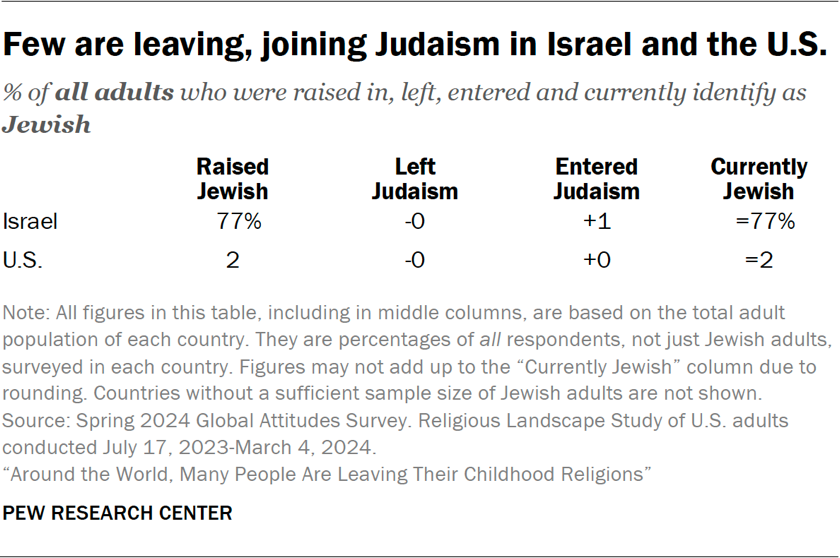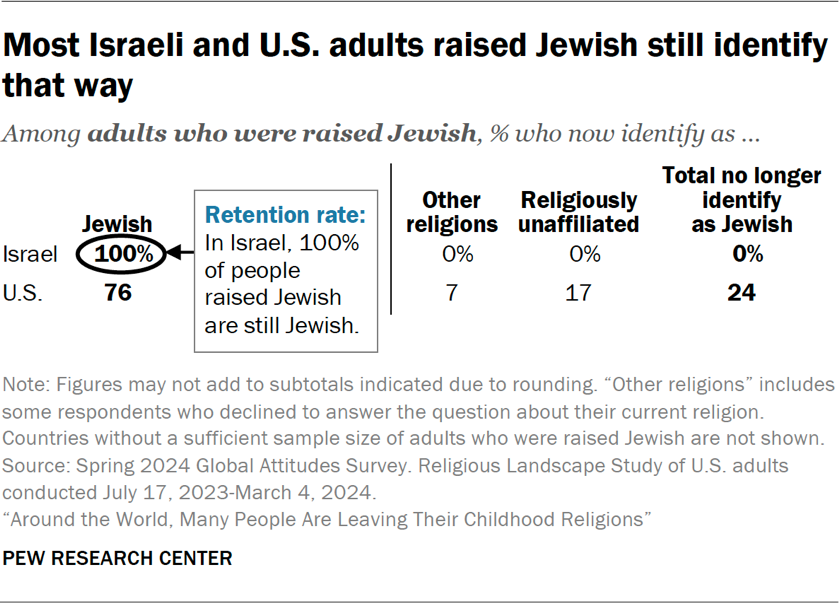This section describes religious switching into and out of Judaism, reviewing the net gains and losses for Judaism in Israel and the United States, what percentage of adults who were raised Jewish are still Jewish (i.e., retention rates), which religious groups those who have left Judaism have switched into, and where Judaism has the largest shares of new entrants (i.e., the highest accession rates).
Around 80% of the world’s Jews live in just two countries: Israel and the United States. Both countries were included in our 2024 survey, allowing us to examine religious switching among a majority of the world’s Jewish population.24
However, people may identify as Jewish in a multitude of ways, including ethnically, culturally, religiously or by family background. In this report, we use the term “Jewish” to mean only religious identity, because the survey questions used in the analyses ask about a person’s current religion and what religious group they were raised in (their childhood religion).
Net gains and losses for Judaism
- Viewed as a percentage of all U.S. adults, few people have left or joined Judaism. But Jewish adults make up only a small fraction of the U.S. population to begin with (about 2%).
Remaining Jewish
- Most people who were raised Jewish in Israel and the U.S. still identify this way today, resulting in high Jewish retention rates in both countries – though it’s higher in Israel than in the U.S.
Leaving Judaism
- In the U.S., about a quarter of adults who were raised Jewish no longer identify as Jewish.
- In Israel, fewer than 1% of adults who were raised Jewish no longer identify as such.
- Most adults who have left Judaism in both countries now are unaffiliated (i.e., they identify religiously as atheist, agnostic or “nothing in particular”).
Entering Judaism
- Most Jewish adults in Israel and the U.S. were raised Jewish, meaning the “accession” (or entrance) rates into Judaism are fairly low in both places.
- But of the two countries, the U.S. has the higher accession rate, with 14% of Jewish Americans saying they were raised outside of Judaism, compared with just 1% of Israeli Jewish adults.
Refer to Pew Research Center’s “4 facts about religious switching within Judaism in Israel” and “Denominational switching among U.S. Jews: Reform Judaism has gained, Conservative Judaism has lost” for analyses of switching within Judaism.
Has Judaism experienced net gains or losses from religious switching?

In Israel and the U.S., the proportion of the overall populations that have either switched into or switched out of Judaism is very small (1% or less). This is true in both places, even though Jewish adults make up a sizable majority of all adults in Israel and a small sliver of all U.S. adults.25
What percentage of people raised Jewish are still Jewish?

The Jewish retention rate is high in both Israel and the U.S. In Israel, virtually all adults who were raised Jewish still identify as Jewish today.26 In the U.S., 76% of adults who were raised Jewish still identify this way.27
Which religious groups have former Jews switched to?
Analyzing retention rates also sheds light on the religious groups that former Jewish adults have joined. In the U.S., 17% of adults who were raised Jewish now identify as unaffiliated, while 2% now identify as Christian and 1% now identify as Muslim.
Between the United States and Israel, which country has seen larger shares of new entrants into Judaism?
In both the U.S. and Israel, the majority of people who currently identify as Jewish say they were raised Jewish, resulting in low “accession” (or entrance) rates into Judaism in both countries.

In the U.S., 14% of Jewish adults say they were raised outside of Judaism. This includes 7% who were raised as Christians and 6% who were raised religiously unaffiliated.




